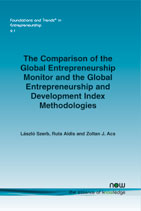The Comparison of the Global Entrepreneurship Monitor and the Global Entrepreneurship and Development Index Methodologies
By László Szerb, University of Pécs, Faculty of Business and Economics, Hungary, szerb@ktk.pte.hu | Ruta Aidis, School of Public Policy, George Mason University, USA, raidis@gmu.edu | Zoltan J. Acs, School of Public Policy, George Mason University, USA, zacs@gmu.edu
Abstract
The Comparison of the Global Entrepreneurship Monitor (GEM) and the Global Entrepreneurship and Development (GEDI) Index Methodologies has four aims: (1) to provide a comprehensive comparison of the GEM and GEDI approaches by using both methods side by side to analyze entrepreneurship development; (2) to offer the GEM community a useful example on how the GEM and the GEDI methodologies can be successfully combined to allow for a more in-depth country analysis of entrepreneurial performance; (3) to provide a comprehensive summary of Hungary's entrepreneurial performance from 2006 to 2010; and (4) to demonstrate the policy applications of the GEDI Index.
The Comparison of the Global Entrepreneurship Monitor and the Global Entrepreneurship and Development Index Methodologies
The Comparison of the Global Entrepreneurship Monitor and the Global Entrepreneurship and Development Index Methodologies has four aims: (1) to provide a comprehensive comparison of the GEM and GEDI approaches by using both methods side by side to analyze entrepreneurship development; (2) to offer the GEM community a useful example on how the GEM and the GEDI methodologies can be successfully combined to allow for a more in-depth country analysis of entrepreneurial performance; (3) to provide a comprehensive summary of Hungary's entrepreneurial performance from 2006-2010; and (4) to demonstrate the policy applications of the GEDI Index. While GEDI is not a panacea for solving all of a country's problems, it is a particularly useful tool for policy-oriented analysis. First, it makes it possible to determine the overall entrepreneurial performance of a country. Second, a country's entrepreneurial performance can be compared to other countries and country groups as well as viewed over time. Third, the pillar and variable level analysis provides an in-depth view of the entrepreneurial strengths and weaknesses of a particular country. Fourth, GEDI offers individual country level policy recommendations. Fifth, GEDI makes it possible to calculate how additional efforts should be distributed in order to provide the greatest increase to entrepreneurship performance. Chapter 1 provides the theoretical basis of the analysis covering relevant definitions, concepts, and measures of entrepreneurship. This chapter also presents a comparative view of the GEM and GEDI methodologies, aims, strengths, and limitations for entrepreneurship policy development. Chapter 2 provides an in-depth presentation of the individual aspects of entrepreneurship based on three entrepreneurial aspects: Entrepreneurial Attitudes, Entrepreneurial Activities, and Entrepreneurial Aspirations. Chapter 3 follows the same structure and focuses on institutional measures for
